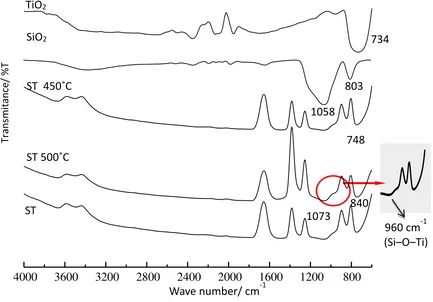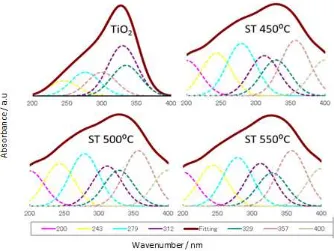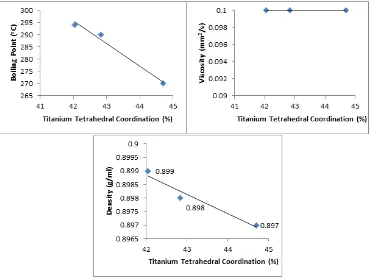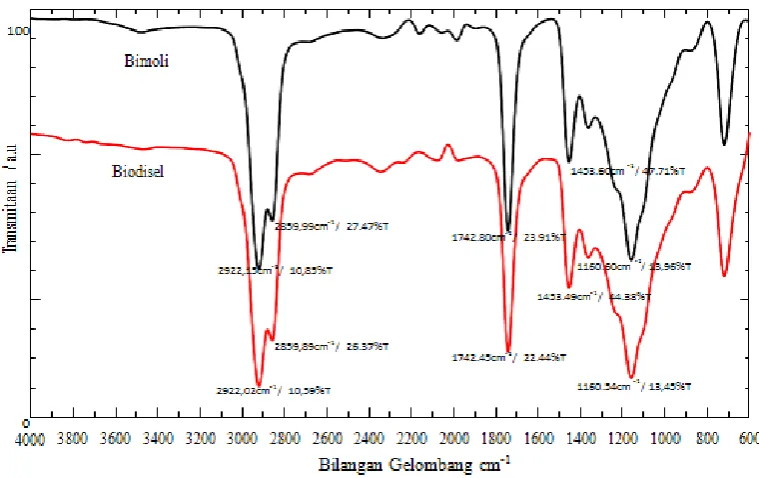IOP Conference Series: Materials Science and Engineering
PAPER • OPEN ACCESS
The Effect of Titanium Tetrahedral Coordination of
Silica-Titania Catalyst on the Physical Properties
of Biodiesel
To cite this article: U K Nizar et al 2018 IOP Conf. Ser.: Mater. Sci. Eng.335 012036
View the article online for updates and enhancements.
Related content
A fuzzy goal programming model for biodiesel production
D S Lutero, EMU Pangue, J M Tubay et al.
-Optimization of mixed base catalyst in the production of Fish oil Biodiesel using Response Surface Methodology (RSM)
E Amruth and Dr. L J Sudev
-Investigation on the effect of titanium (Ti) addition to the Mg- AZ31 alloy in the as cast and after extrusion conditions on its metallurgical and mechanical
characteristics
Adnan I. O. Zaid, Raghad and S. Hememat
1234567890‘’“”
ICOMSET IOP Publishing
IOP Conf. Series: Materials Science and Engineering 335 (2018) 012036 doi:10.1088/1757-899X/335/1/012036
The Effect of Titanium Tetrahedral Coordination of
Silica-Titania Catalyst on the Physical Properties of Biodiesel
U K Nizar1*, J Hidayatul1, R Sundari2, B Bahrizal1, A Amran1, A Putra1, L
Latisma DJ1, I Dewata1
1Department of Chemistry, Universitas Negeri Padang, Jl. Prof. Hamka, Air Tawar,
Padang, West Sumatera, Indonesia
2Departement of Mechanical Engineering, University of Mercu Buana, Jakarta
Abstract. This study investigates the correlation of the number of titanium tetrahedral coordination and biodiesel production. The solid-state method has been used to synthesis of silica-titania catalyst for biodiesel production, which the precursors, i.e. silica and titania commercials were heated in the temperature range of 450 - 550oC. The characterization of the
prepared silica-titania has been studied by FTIR and DR UV-Vis in order to identify and calculate the presence of titanium tetrahedral coordination in silica-titania catalyst. A very small peak at around 950 cm-1 indicated the presence of titanium tetrahedral coordination
through Si–O–Ti bonds. Deconvolution of DR UV-Vis spectra showed the coordination of titanium in silica-titania is more octahedral. However, the number of titanium tetrahedral coordination of the prepared silica-titania is found higher than that of TiO2 commercial. The
increasing of titanium tetrahedral fraction in silica-titania affects the physical properties of biodiesel in terms of boiling point, viscosity and density, which is produced by the reaction of methanol and palm oil.
1. Introduction
The biodiesel production has developed on going with the reduction of natural resources from fossil fuel globally, high increase of world crude oil price and increasing environmental problem due to fossil fuel. Biodiesel is one of the most promising alternative fuels because it has several benefits over problems generated by fossil fuel. The added value of biodiesel is that its properties close to properties of diesel fuel; an engine using biodiesel does not need to be modified and lubricating property of biodiesel is better than that of diesel and therefore, it can overcome exhausted engine and maintenance cost of engine (1–3).
2
1234567890‘’“”
ICOMSET IOP Publishing
IOP Conf. Series: Materials Science and Engineering 335 (2018) 012036 doi:10.1088/1757-899X/335/1/012036
mixed with the catalyst used, thus, the separation process is not simple and requires high cost (not economics). When the separation is not good the biodiesel yield is still mixed with the catalyst and causes corrosion of engine (6). Several obstacles found in homogeneous catalyst can be overcome by the utilization of a heterogeneous catalyst. The biodiesel product has different phase from that of the catalyst and therefore, the separation process is more simple and economics. In addition, the used catalyst can be reused for next reactions (1).
Silica-titania (SiO2-TiO2) is one of binary oxides, which is important in the heterogeneous catalyst group. The utilization of silica-titania as a catalyst in the synthesis of biodiesel has not been widely reported. Based on the literature study, the silica-titania reported as catalyst in biodiesel fabrication was the substituted silica-titania with sulfate group. In general, the reaction product shows the higher catalytic activity of silica-titania and titania-sulfate with a conversion achievement of 90%. However, the percentage increasing of biodiesel yielded is not proportional with the percentage of sulfate group in silica-titania(7).
Several important matters such as the stability of silica-titania with sulfate group during calcinations, the correlation of sulfate composition and percentage of conversion, the existence of tetrahedral framework in silica-titania and stability of sulfate group during reaction of biodiesel fabrication have not been elucidated in previous work. The tetrahedral framework of titanium is known very active and determines the catalytic activity of titanium in silica-titania. The formation of tetrahedral framework through Si–O–Ti bond causes acidic properties on silica-titania surface increased due to different in geometrical form and coordination of Si and Ti (8). The acidic properties are much required for a catalyst in the fabrication of biodiesel.
This study reported the effects of titanium tetrahedral framework in silica-titania on the physical properties of biodiesel yielded. The synthesis of silica-titania is based on the solid state method because it is more eligible for solid precursors and low cost fabrication, compared to another method i.e. sol-gel method(9–11). Characterizations of samples applied FTIR and DR UV-Vis. The fraction of titanium tetrahedral in the synthesized silica-titania was calculated applying deconvolution of UV spectra and examined in biodiesel fabrication from the reaction of palm oil and methanol. The physical properties of biodiesel product including boiling point, viscosity, and density were determined.
2. Experimental
2.1. Chemicals
Titanium oxide (Acros), silica (Sigma Aldrich), and toluene (Merck) were purchased and used in this study. Palm oil (Bimoli) and methanol (Merck) were used for biodiesel synthesis.
2.2. Synthesis of silica – titania
Synthesis of silica-titania was done by mixing respective 10 mmol silica and 10 mmol titania (1 : 1) in 10 ml toluene. The mixture was sonicated using ultrasonic equipment for 1h to disperse silica and
The FTIR characterization was used to identify type of chemical bonding in the mixture of silica and titania. The samples were analyzed in wave number range of 4000 – 400 nm-1. The DR UV-Vis
1234567890‘’“”
ICOMSET IOP Publishing
IOP Conf. Series: Materials Science and Engineering 335 (2018) 012036 doi:10.1088/1757-899X/335/1/012036
2.4. Application of silica-titania catalyst for synthesis of biodiesel l(1,6,11-12)
In general, the synthesis of biodiesel was done through transesterification reaction of commercial palm oil and methanol with addition of silica-titania catalyst. The mole ratio of methanol and palm oil was made as 6 : 1, and the amount of catalyst was taken as 10% from the weight of palm oil. The mixture was homogenized by a magnetic stirrer and heated for 3h at 65oC. Then the mixture was cooled and
the separation process was done between the product with catalyst and excess methanol. The first separation was done for catalyst by centrifuging. The next separation was done for excess methanol using rotary evaporator at temperature above boiling point of methanol. The biodiesel product was characterized with FTIR and the physical properties were examined for boiling point, viscosity, and density.
3. Result and Discussion
3.1 FTIR spectra of silica-titania prepared by solid state method
FTIR spectra of TiO2, SiO2 and series of SiO2-TiO2 synthesized based of various calcinations at
450oC, 500oC, and 550oC are shown in Figure.1. As seen in Figure.1, the spectrum of TiO
2 shows
band absorptions at 734 cm-1 and 2352 cm-1. The band absorption at 2352 cm-1 indicates the absorption
of Ti-O, while the absorption at 734 cm-1 is attributed to absorption of Ti-O-Ti. The spectrum of SiO 2
is attributed by the main band absorptions at wave numbers of 1058 cm-1 and 803 cm-1, respectively.
The band absorption at wave number of 1058 cm-1 is attributed to asymmetric stretching vibration of
Si-O-Si, and that of 803 cm-1 is related to symmetric stretching vibration of Si-O-Si (7)(14).
4
1234567890‘’“”
ICOMSET IOP Publishing
IOP Conf. Series: Materials Science and Engineering 335 (2018) 012036 doi:10.1088/1757-899X/335/1/012036
The FTIR spectra of SiO2-TiO2 series are presented by main band absorptions at respective wave
numbers of 3668 cm-1, 3429 cm-1, 1073 cm-1, 960 cm-1, 840 cm-1 and 748 cm-1. The broad band
absorptions at wave number of 3668 cm-1 dan 3429 cm-1 show the –OH stretching vibration of sample
surface. The –OH band absorption is due to the existence of water vapor generated during FTIR characterization process (10). Other band absorptions observed are the weak broad band at wave number of 1073 cm-1 and weak absorption band at 840 cm-1. That band absorptions are related to
asymmetric and symmetric stretching vibrations of Si-O-Si. In addition, a weak broad band absorption at wave number of 748 cm-1 is attributed to vibration of Ti-O-Ti (7). A very small band absorption at
wave number of 960 cm-1 is due to vibration of Si–O–Ti bonding. This bonding is an indication of
chemical interaction between SiO2 and TiO2. More bonding of Si–O–Ti formed indicated more
titanium tetrahedral fractions generated in SiO2 and TiO2 (15). The formation of Si–O–Ti bonding is
verified and confirmed by deconvolution band absorption of DR UV-Vis spectra (15–17).
3.2. Deconvolution of DR UV-Vis spectra
The deconvolution spectra of DR UV-Vis has been done to examine the effect of calcinations on titanium tetrahedral fraction and to evaluate the titanium tetrahedral fraction due to formation of Si– O–Ti bonding. According to literatures, the DR UV-Vis spectra in the range of 200 - <280 nm is attributed to tetrahedral region and that above than 280 nm is related to octahedral region as well as shown in Figure. 2 (10).
Figure 2. Deconvolution of DR UV-Vis spectra of TiO2 and SiO2-TiO2 series
On the basis of deconvolution calculation the band absorptions at 200, 242 and 279 nm is corresponding to titanium tetrahedral fraction and that at 312, 329, 358 and 400 nm is related to titanium octahedral fraction. In general, silica-titania catalyst prepared by TiO2 and SiO2 solids is
likely to form more octahedral fraction rather than tetrahedral fraction. However, the result of this investigation shows an increase of titanium tetrahedral fraction compared to TiO2 commercial. The
1234567890‘’“”
ICOMSET IOP Publishing
IOP Conf. Series: Materials Science and Engineering 335 (2018) 012036 doi:10.1088/1757-899X/335/1/012036
Table 1. Percentage of titanium tetrahedral based on deconvolution of DR UV-Vis spectra
Sample Calcinations Symbol Tetrahedral
TiO2 - TiO2 27,10 %
SiO2-TiO2 450 °C ST 450˚C 43,03 %
SiO2-TiO2 500°C ST 500˚C 42,11 %
SiO2-TiO2 550°C ST 550˚C 41,87 %
On the basis of deconvolution DR UV-Vis spectra the titanium tetrahedral fraction increased from 27,10% to 43,03%. This phenomenon verified the formation of Si–O–Ti bonding due to interaction between SiO2 and TiO2, which was verified by FTIR spectra through the existence of band absorption
at 960 cm-1. Thus, it can be concluded that both results of FTIR and deconvolution of DR UV-Vis
spectra are in good agreement.
3.3. Biodiesel synthesis
Generally, transesterification reaction produces biodiesel or methyl ester in liquid phase with glycerol as by-product (3). However, transesterification is not occurred but saponification with soap as main product. In order to confirm the formation of biodiesel at this preliminary investigation, several physical properties of the product are compared with that of its crude oil (Table 2). The characterization included density, viscosity and boiling point.
Table 2. Physical properties of crude oil and biodiesel product.
Sampel
Physical properties
Density (g/ml) Viscosity (ml/s)
Boiling point
(0C)
Palm Oil (Bimoli) 0,9055 0,0909 315
Biodiesel (ST 400°C) 0,8978 0,098 290
Biodiesel (ST 450°C) 0,8972 0,098 288
Biodiesel (ST 500°C) 0,8981 0,0961 290
6
1234567890‘’“”
ICOMSET IOP Publishing
IOP Conf. Series: Materials Science and Engineering 335 (2018) 012036 doi:10.1088/1757-899X/335/1/012036
Figure 3. The correlation between titanium tetrahedral fraction in catalyst SiO2-TiO2 with physical
properties of biodiesel.
Figure. 3 shows the increased titanium tetrahedral fraction in silica-titania catalyst causing decreased in both density and boiling point of biodiesel product but increased in its viscosity. This
investigation is attributed to higher the quantity of titanium tetrahedral fraction causing better catalytic activity of silica-titania catalyst. The obtained results is in accordance with previous studies described that catalytic properties of silica-titania is influenced by its local structure, i.e. the tetrahedral as active local structure (10).
In addition, the FTIR apectra is also used to examine the change of functional groups from crude oil to methyl ester as shown in Figure.4 with respect to biodiesel product (450oC). The substantial
absorption peaks of palm oil (bimoli) are appeared at wave number of 2922.15 cm-1, 2859.99 cm-1,
1742.80 cm-1, 1453.60 cm-1 and 1160.60 cm-1 and the remarkable absorption peaks of biodiesel
product (450oC) are attributed at wave number of 2922.02 cm-1, 2859.89 cm-1, 1742.45 cm-1, 1453.49
cm-1 and 1160.54 cm-1. The strong band absorption at wave number 1800 – 1700 cm-1 is attributed to
C=O, while the band absorption at wave number 1170 – 1200 cm-1 is related to C-O-C vibration of
methyl ester and weak absorption at 1600 – 1450 cm-1 is corresponding with vibration of C-C group.
In addition, strong band absorption at 3000 – 2800 cm-1 is related to C-H vibration of methyl group
1234567890‘’“”
ICOMSET IOP Publishing
IOP Conf. Series: Materials Science and Engineering 335 (2018) 012036 doi:10.1088/1757-899X/335/1/012036
Figure 4. FTIR spectra of crude oil and biodiesel
4. Conclusion
The synthesis of silica-titania from solid precursors using solid-state method can increasing the number of titania tetrahedral framework in silica-titania, compared to the commercial titania. The highest number of titanium tetrahedral obtained by calcining the mixture of titania and silica precursors at 450oC for 8hr. The properties of biodiesel formed during transterification between palm
oil and methanol affected by silica-titania. It was proved by the determination of boiling point, viscosity and density.
Acknowledgement
We gratefully acknowledge the funding from Ministry of Research, Technology and Higher Education of the Republic of Indonesia and Universitas Negeri Padang for financial support under PNPB 2017 research grant.
References
[1] Chouhan APS, Sarma AK. Modern heterogeneous catalysts for biodiesel production: A comprehensive review. Renew Sustain Energy Rev. 2011;15(9):4378–99.
[2] Lokman IM, Rashid U, Taufiq-Yap YH. Meso- and macroporous sulfonated starch solid acid catalyst for esterification of palm fatty acid distillate. Arab J Chem [Internet]. 2016;9(2):179– 89.
[3] Ilmi M, Kloekhorst A, Winkelman JGM, Euverink GJW, Hidayat C, Heeres HJ. Process intensification of catalytic liquid-liquid solid processes: Continuous biodiesel production using an immobilized lipase in a centrifugal contactor separator. Chem Eng J. 2017;321:76– 85.
[4] Axelsson L, Franzén M, Ostwald M, Berndes G, Lakshmi G, Ravindranath NH. Perspective:
Jatropha cultivation in southern India: Assessing farmers’ experiences. Biofuels, Bioprod
Biorefining. 2012;6(3):246–56.
8
1234567890‘’“”
ICOMSET IOP Publishing
IOP Conf. Series: Materials Science and Engineering 335 (2018) 012036 doi:10.1088/1757-899X/335/1/012036
[6] Talebian-Kiakalaieh A, Amin NAS, Mazaheri H. A review on novel processes of biodiesel production from waste cooking oil. Appl Energy. 2013;104:683–710.
[7] Shao GN, Sheikh R, Hilonga A, Lee JE, Park YH, Kim HT. Biodiesel production by sulfated mesoporous titania-silica catalysts synthesized by the sol-gel process from less expensive precursors. Chem Eng J. 2013;215–216:600–7.
[8] Chmielarz L, Gil B, Kuśtrowski P, Piwowarska Z, Dudek B, Michalik M. Montmorillonite-based porous clay heterostructures (PCHs) intercalated with silica–titania pillars—synthesis and characterization. J Solid State Chem. 2009;182(5):1094–104.
[9] Ningsih SKW. Synthesis and characterization of NiO nanopowder by sol-gel process. AIP Conf Proc. 2015;1677.
[10] Nizar UK, Efendi J, Yuliati L, Gustiono D, Nur H. A new way to control the coordination of titanium (IV) in the sol-gel synthesis of broom fibers-like mesoporous alkyl silica-titania catalyst through addition of water. Chem Eng J. 2013;222:23–31.
[11] Sundari R, Hua TI, Aziz M, Nizar UK. the Characterization Study of Ferrites ( Magnesium and Manganese ) Using Sol Gel Method. 2014;18(3):485–90.
[12] Najem S, Khurshid A. Biodiesel production by using heterogeneous catalyst Biodiesel production by using heterogeneous catalyst. 2014;(March).
[13] Jansri S. Preparation of Vegetable Oil as Biodiesel Feedstock Via Re-Esterification: A Suitable Catalyst [Internet]. Vol. 79, Energy Procedia. Elsevier B.V.; 2015. 143-148 p.
[14] Ruzimuradov ON. Formation of bimodal porous silica-titania monoliths by sol-gel route. IOP Conf Ser Mater Sci Eng. 2011;18:32004.
[15] Ren J, Li Z, Liu S, Xing Y, Xie K. Silica–Titania mixed Oxides: Si–O–Ti Connectivity, Coordination of Titanium, and Surface Acidic Properties. Catal Letters. 2008;124(3–4):185– 94.
[16] Kholdeeva O a, Trukhan NN. Mesoporous titanium silicates as catalysts for the liquid-phase selective oxidation of organic compounds. Russ Chem Rev. 2007;75:411–32.
[17] Nur H. Modification of titanium surface species of titania by attachment of silica nanoparticles. Mater Sci Eng B Solid-State Mater Adv Technol. 2006;133(1–3):49–54.
[18] Tonucci L, Coccia F, Bressan M, D’Alessandro N. Mild photocatalysed and catalysed green




